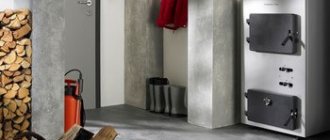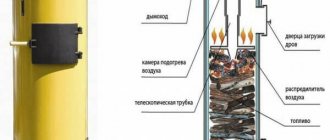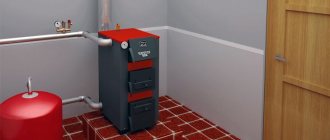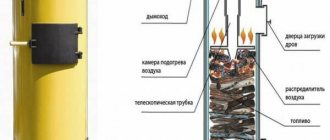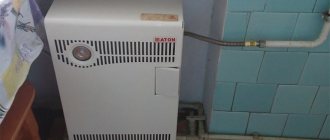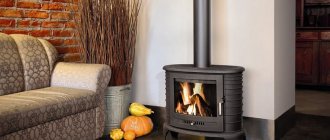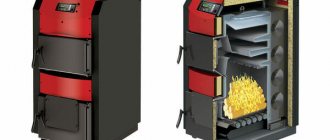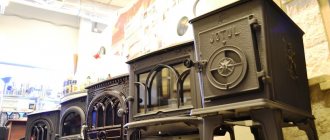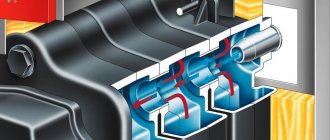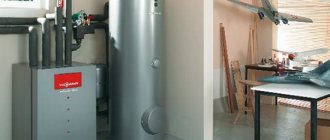The option of purchasing a solid fuel boiler for autonomous heating of premises often becomes one of the best options due to its simplicity and reliability.
However, choosing a unit is a non-trivial process. To make your task easier, we have compiled a rating of the best solid fuel boilers with a water circuit.
When selecting models, we took into account the opinions of experts and installation specialists, user reviews and technical characteristics of the devices.
Here you will find only the best models in terms of price/quality ratio.
Rating of the TOP 15 best solid fuel boilers with a water circuit for 2021-2022
| Place | Name | Price |
| TOP 4 best solid fuel boilers with a water circuit in price/quality ratio for 2021-2022 | ||
| 1 | Teplodar Cooper Praktik 8 single-circuit | Find out the price |
| 2 | ZOTA Yenisei 14 14 kW single-circuit | Find out the price |
| 3 | Lemax Forward-16 17 kW single-circuit | Find out the price |
| 4 | Teplodar Uyut-10 10 kW single-circuit | Find out the price |
| TOP 4 best solid fuel boilers with a water circuit and electric heating element | ||
| 1 | Teplodar Kupper Praktik 14 14 kW single-circuit | Find out the price |
| 2 | Teplodar Kupper OK 15 15 kW single-circuit | Find out the price |
| 3 | Teplodar Kupper Expert-15 single-circuit | Find out the price |
| 4 | Teplodar Kupper OVK 18 18 kW single-circuit | Find out the price |
| TOP 4 best cast iron solid fuel boilers with a water circuit | ||
| 1 | Krontif Siberia 60 single-circuit | Find out the price |
| 2 | Kentatsu MAX-04 38 kW single-circuit | Find out the price |
| 3 | Sime SOLIDA EV 6 56 kW single-circuit | Find out the price |
| 4 | Krontif Siberia 30 single-circuit | Find out the price |
| TOP 3 best solid fuel boilers with a water circuit using wood | ||
| 1 | ZOTA Box 8 8 kW single circuit | Find out the price |
| 2 | Teplodar Kupper OK 9 9 kW single-circuit | Find out the price |
| 3 | Lemax Forward-12.5 13 kW single-circuit | Find out the price |
Fuel options
The fuels used in solid fuel boilers are:
- firewood and wood processing waste (chips, sawdust, pellets - pressed sawdust);
- hard and brown coal (however, be careful, not all combustion chambers are designed for the high combustion temperature of coal);
- fuel briquettes;
- peat.
Some equipment runs on only one fuel (wood or coal), most use any solid fuel, but there are boilers with additional accessories or the ability to install a burner, which allows them to use liquid fuel if necessary.
It is necessary to clearly understand that the rated capacity of the boiler depends on the calorie content and quality of various fuels. The maximum boiler power is indicated for certain fuel characteristics under optimal operating conditions. Using raw firewood or pellets can lead to a 30% loss of power, accelerated formation of ash and soot, which shortens the service life of the unit.
Inexpensive solid fuel boilers are practically omnivorous, as long as the fuel is dry, but with the growing desire for automation, the importance of pellets is increasing. They have a number of advantages:
- it is convenient to load into the firebox both manually and automatically from the hopper with an auger;
- easy to organize storage;
- release of about 5 kW of thermal energy from 1 kg;
- the use of low-ash pellets reduces the amount of ash.
The use of hard and brown coal for fuel is justified in places where they are easily accessible and affordable.
Pellet boilers with automatic fuel supply Burning duration from 7 to 30 days thanks to the storage bunker
How to choose a solid fuel boiler?
The choice of a solid fuel boiler should be accompanied by taking into account the following points:
:
- The heating area is the main characteristic when choosing a boiler unit, usually at the rate of 1 kW per 1 sq.m., however, it is better to take into account not the area, but the volume of the room.
- Types of fuel - not all modern models, like the good old stoves, are omnivorous in terms of fuel. Some options are also very sensitive to it and will not only not provide the specified characteristics, but will also create problems in operation, or even fail altogether.
- Energy independence - of course, most solid fuel boilers are independent of electricity, but pellet options are equipped with electronics that require uninterrupted power.
Reviews of double-circuit solid fuel boilers: advantages and disadvantages
| Advantages | Flaws |
| This is the most budget option for organizing hot water supply in the house | Fuel loading in inexpensive boilers is done manually and frequently; if it is necessary to heat the secondary circuit, fuel consumption increases |
| High efficiency and low cost of fuel compared to gas and electricity makes the economics of use profitable | Creation of a warehouse for fuel reserves, at least under a canopy or tarpaulin. |
| Most models do not require complex maintenance | Cleaning spools and removing ash - the main work is done manually on most boilers. |
| Switching from one solid fuel to another type does not require costs | Periodic inspection of the chimney, pipes and fittings. |
| Without using the secondary circuit, these are classic, equally efficient HT boilers | Limited selection of dual-circuit TT models on the Russian market |
Which company should you choose?
Solid fuel boilers equipped with a water circuit are produced by various manufacturers, among which stand out:
- Teplodar is a Russian company with patented technologies that supplies high-quality heating equipment throughout the world.
- Zota is a Krasnoyarsk brand that supplies inexpensive components and boilers of low cost and high build quality.
- Stropuva is a young Lithuanian company that has patented a candle-type long-term combustion technology. It produces models taking into account the climatic characteristics of countries and regions.
The best known manufacturers and models: characteristics and prices
Karakan 16TPEV 3 16kW
A double-circuit boiler that is popular in rural areas and uses any solid fuel. First of all, it gained popularity due to its deep firebox, which allows the use of firewood up to 50 cm long and a hob. For classical combustion boilers, it has a sufficient efficiency of 75%, producing 250 l/hour of hot water. The preparation of sanitary hot water is carried out using a built-in heating element with a power of 9 kW. When operating for heating, the boiler is completely energy-independent, with mechanical control via a thermostat. The weight of the unit is 120 kg.
Dragon Ta-15 Gv
One of the best double-circuit solid fuel boilers for heating a private home. A more advanced, efficient, practical and easy to maintain, but also much more expensive boiler. The efficiency reaches 88%, which was achieved by designing a combustion chamber with a longer gas removal time, due to which more heat is accumulated by the heat exchanger. Also worth noting among the features is the considerable volume of the firebox - 60 liters, the manufacturer claims 6-10 hours of burning of one bookmark. In practice, this is true, but when using coal with low ash content as fuel.
The design of the door allows for the additional installation of a liquid fuel burner, but we recommend doing this only as a last resort: the efficiency of burning gas, diesel fuel or exhaust in a large combustion chamber of a solid fuel boiler will be extremely low. Owners also note the cast iron grate. The only drawback is the extremely high price.
Cost: 53,500-62,000 rubles.
Wirbel ECO SKB 20
Development in Austria, production usually in the Russian Federation. An even more advanced model with complex gas removal, which accumulates more heat. The main serious difference is the organization of the second circuit through a storage boiler built into the main circuit with a capacity of 65 liters or more, which allows you to always have a certain supply of hot water in stock, but reduces efficiency if the boiler is used only for heating the house. It is also worth noting the reliability of the heat exchanger made of thick 5 mm furnace steel; in practice, such heat exchangers of other models last more than 15-17 years.
The only disadvantages are the high price and low prevalence; the boiler is quite difficult to find for sale in the Russian Federation.
Trayan T-15-2KT
The boiler is completely Russian-made, the only difference is a large combustion chamber of 80 liters, which can accommodate logs up to 55 cm, which is extremely practical. At the same time, it has extremely compact dimensions. Otherwise, it is not as efficient and technologically advanced as the models mentioned above, and is inferior to its analogues in terms of a set of parameters. Despite the existing demand and prevalence of the model, in our opinion, its prices are too high.
Cost: 47,000-58,000 rubles.
Ratings on the Internet are relative, but comparing characteristics and prices gives an idea of the models and manufacturers.
Principle of operation
Boiler units are quite simple in their operating principle, based on the basic laws of physics.
The principle itself includes successive points:
- Loading a suitable type of fuel;
- Ignition of fuel using a burner or other fire source;
- Combustion of fuel, during which heat is released and thermal energy is transferred to the coolant for the heating circuit or hot water supply;
- Exhaust of flue gases into the atmosphere through a chimney by natural or forced circulation;
- Natural or forced circulation of heated coolant through the heating system.
Device Features
A fireplace stove with a built-in water circuit is a steel chamber with varying wall thicknesses . In a closed system the indicator will be 6 millimeters, in an open system - 4 millimeters.
Heat exchanger tubes are mounted between the walls to circulate the coolant liquid. To be able to control the temperature in the oven, temperature sensors are installed.
The air flow into the combustion chamber is usually adjusted manually.
NOTE!
Exterior design can be made using various materials in order to fully comply with the overall style of the interior.
In summer, such equipment can only be used for water heating.
What is the essence of the problem
The heating boiler was invented precisely to replace the stove as a heat-generating device in heating systems (CO). The boiler is a continuous operation device that ideally requires the user only to periodically reload fuel and seasonal maintenance. Its fundamental difference from a furnace is its automation, which maintains the combustion mode optimal for a given operating mode. Automation is not necessarily electronic; it can be a non-volatile combination of bimetallic plates, springs and levers.
The oven is a manually operated intermittent device, which is why it is cheaper. It's not about the automatic transmission. It's about the very fundamentals of the approach to design and production. Specifically, in the methods of organizing complete combustion of fuel. If we continue the shipbuilding analogy, then the boiler is no longer a displacement vessel, but a glider. Which can also float like a steamship, but will show its full qualities only when it reaches the redans. However, planing requires relatively calm water; a properly constructed and adjusted CO, figuratively speaking, is what it is for a boiler. The furnace (continuing the same analogy) under the control of an experienced crew can go at full speed in significant seas. Thanks to this reserve of operational endurance, it is possible to adapt the stove for water heating. Full speed (the same analogy) will be quieter than that of a glider (maximum thermal efficiency 60-65% versus 80-95%), but, “going at economic speed in calm water,” the specific fuel consumption for heating a unit of cubic capacity of a house can do not exceed that of the boiler.
Note: the thermal efficiency of heat-generating devices is a complete analogue of the efficiency for internal combustion engines.
Furnace in the system
It is not enough to build a heating furnace with a water circuit correctly. It is also necessary to correctly develop a CO for it, and to properly include a stove in it.
Let's take a brief look at the ways of organizing CO. Whether our system will be single-pipe, 2-pipe, series, parallel or mixed is an important question, but another one from the point of view of the efficiency of using the heat of the furnace to heat the house. From the point of view of capabilities, cost, convenience, simplicity and energy independence of pairing the furnace and CO, it is more important to disassemble the systems:
- Open gravity (gravity flow).
- Open with forced circulation.
- Closed without excess pressure.
Gravity
Purely thermosiphon CO (like the internal combustion engine cooling systems of early cars) does not exist - losses in long CO pipelines will suppress thermosiphon circulation. For CO to still work, it needs to call upon a certain, quite definite share of gravity to help it (in a purely thermosiphon circulation, the share of gravitational pressure can be arbitrarily small).
The principle of operation of gravitational CO is shown on the left in the figure:
Construction of an open gravity heating system
If the system is operated from the stove in the house, it is impossible to fulfill the condition indicated in the center, even if the batteries are suspended from the ceiling. In this case, a CO with a high-mounted flow-through expansion tank (on the right in the figure) can help out; it will create the additional pressure necessary for thermosiphon circulation of the coolant. In centralized COs, a system with a flow expander is not used, because requires greater consumption of materials, labor costs for maintenance and, when used on a large scale, results in large losses of coolant. But in a private home, all this is more than compensated for by the simplicity, cheapness and stability of the operation of this CO. Its highlight is the expansion tank. The requirements for it are:
- A capacity of 200 liters is more than enough for a house up to 120-150 sq. m. m residential.
- It is convenient to make a tank from a barrel placed on the butt, i.e. vertically.
- Make-up and CO supply - only upper ones through the tank.
- The tank must be reliably thermally insulated: for circulation to occur, the water in it only needs to cool by 1-2 degrees, and heat loss from an uninsulated tank will be excessively large.
- The tank is filled halfway, like a regular expansion tank.
- To avoid evaporation of the coolant and clogging it with dust, the tank must be closed with a tight lid with thermal insulation and air drainage.
- The outlet pipe protrudes 5-7 cm above the bottom to avoid clogging the pipes with sludge.
- The mouth of the inlet pipe is located no lower than 15 cm above the outlet, but not higher than 20-25 to the water surface at its minimum level, otherwise air may be sucked into the system (water from the inlet pipe is in full swing and can be drawn into the outlet air).
Backup (emergency) electric boiler for water heating systems with a furnace
Note: since it is impossible to constantly heat a brick stove and refill CO with antifreeze, and a winter cottage with a stove can, in addition, be left for several days, it is highly advisable to include an emergency electric boiler in the system (see figure on the right). It will maintain the temperature of the water in the system above freezing; as a rule - at the level of 5 degrees Celsius. True, the backup boiler also consumes a lot of electricity per day.
With pump
Forced circulation COs are built only with metal furnaces if required by the furnace manufacturer's specifications. The intensity of heat transfer from a brick stove is too low for this: the house will be cold, the stove will get cold, and unused heat will fly away into the chimney in the form of unburned fuel.
For CO with a furnace, firstly, from the possible schemes of systems with forced circulation of coolant (see figure), you need to choose a scheme with a high-mounted expansion tank (highlighted in red). In the event of a power failure, it will provide minimal circulation to prevent the system from defrosting. If there is no backup electric boiler, the stove must be heated all the time, but little by little, so that the water in the system does not boil. Therefore, such a CO requires a supply water temperature sensor.
Schemes of open-type heating systems with a circulation pump
Secondly, the circulation pump must be equipped with a bypass (bypass in English - bypass) with a check valve, see fig. below. Without a bypass, both the system and the pump will freeze, because... the tiny thermosyphon pressure will not push water through it.
Operation diagram and appearance of the circulation pump of the heating system with bypass (bypass shunt)
Closed
Quite expensive closed COs with a membrane expansion tank are used with furnaces quite often, because they are compact, work with both metal and brick stoves and fit relatively easily into the interior of the house: the entire CO piping can be located in a cabinet next to the stove (see the figure at the beginning). The device of a closed CO operated from the furnace has no special features; It is mandatory to have an automatic or manual valve to dewater the system, see next. rice..
Construction of closed heating systems
Installation
In accordance with the rules and regulations, you can install a wood-burning boiler yourself. Installation, in this case, is carried out on a base that is distinguished by its non-flammable characteristics and durability. And the cladding of the floor and nearby walls must be made entirely of non-combustible materials.
To install the chimney, cutting is used in accordance with fire safety rules. For example, where flammable material is adjacent to the wall surface, it is necessary to lay fire-resistant insulation. Steel sheet is used to cover the entire material.
- The water heating coming from the boiler is connected to specially designed outlets. The instructions indicate a specific pipe for the return and connection of the circuit. If the power exceeds forty kilowatts, then the boiler must be installed in a separate room.
- A boiler that depends on electricity consumption must be connected through a stabilizer device, as well as a source that ensures an uninterrupted power supply.
- Automatic machines must be used with a direct connection from the panel. And if necessary, installation can be done directly in the basement. Only here there should be both adequate ventilation and lighting provided naturally.
To increase the efficiency, you need to heat according to all the rules, and also lay wood only with the required degree of humidity.
Selection of pipes for distribution
The final result, which consists in preserving and saving heat, depends on the quality of each system part, so the longest elements - pipes - must also be given some attention.
From a technological point of view, pipes and fittings must have the following qualities:
- strength;
- ease;
- suitability for repair;
- tightness;
- low noise level.
Low cost is also an important component when choosing, because heating system equipment requires a large number of products for various purposes.
Polypropylene pipes are the best option for self-assembly of a heating system. You can learn to use a soldering machine for stitching pipes in 10 minutes
Nowadays, hardly anyone will undertake the installation of wiring from metal pipes. Steel, copper and galvanized products are becoming a thing of the past, giving way to cheaper and more functional analogues.
The best alternative is polymer products. which can be divided into three groups:
- polypropylene;
- metal-plastic.
The advantages of polypropylene pipes are low cost, ease of welding, and long service life. Disadvantage: lack of elasticity. When replacing a pipe, you will have to change the entire fragment from connection to connection.
On a long section of the pipeline, polypropylene pipes sag, as they have an expansion of 6 mm/5 m. Strong fixation is ensured using brackets or clips mounted in the wall at intervals of 1-1.1 m
Durable metal-plastic pipes are resistant to sudden temperature changes. Capable of serving without major repairs for up to 30 years. The weak point is the connecting elements - fittings with an unreasonably narrowed cross-section. If the coolant freezes, a breakthrough is likely.
When choosing pipes, focus on the main technical indicators of the equipment and the type of coolant.
Advantages
- Economical. The services of a stove maker will cost much less than the purchase of modern devices, their maintenance and installation. The stove can be made from mortar and bricks that were left over after building the house. Repair and operation of such devices does not require large investments.
- Design variability. A modern master can build a stove of any shape and size. It can be decorated with exquisite designer decor and painted in various colors. There are designs that combine a fireplace and stove.
- High degree of maintainability. Over many years of operation, this equipment requires only minor cosmetic repairs. This is much faster, cheaper and easier than taking an expensive unit for service.
- Possibility of regulation of combustion intensity in the firebox.
- An atmosphere of comfort, which is characteristic only of Russian ancient huts with stoves.
- The intensity and speed of air heating is determined by the position of the dampers.
Heat exchanger
Various materials are used for stoves with water heating boilers:
- Low-carbon steel, in the form of a coil of pipes with a diameter of 4 to 5 cm (or an assembly of sheet steel, up to 0.5 cm thick);
- Cast iron, use old batteries made from it, preferably compact in size (to fit in the firebox);
- Copper (the most expensive option).
A tubular steel device is more efficient in operation, but more difficult to manufacture. Disadvantage of cast iron products: they are difficult to clean from accumulating soot (ribs get in the way). Copper cameras are rarely used, they are difficult for the owner to assemble, and expensive to purchase.
By the way. The heat exchanger significantly reduces the usable area of the firebox. There must be a gap between them - up to 15 mm (for products made of sheet steel - up to 10 mm).
Circuit
The pipeline consists of a supply from the furnace and a return to it. In the room farthest from the stove, both branches are connected. In other rooms they run in two lines along the outer walls.
On a note! This option is cheaper than a system with radiators and is easier to install.
